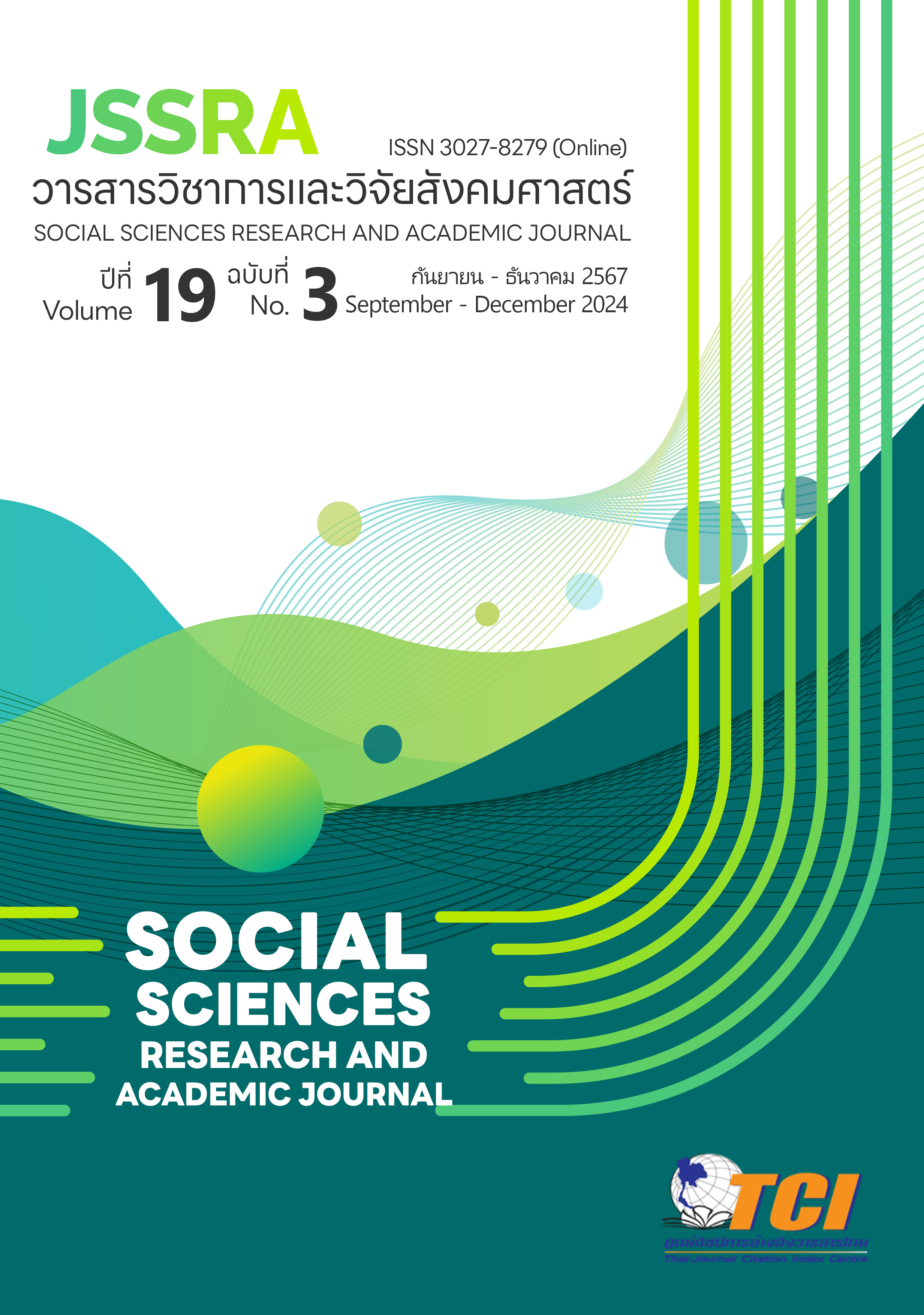การพัฒนาเครื่องมือวัดและโมเดลการเปลี่ยนกลุ่มแฝงทักษะการทำงานร่วมกันของนิสิตครูระดับปริญญาตรี
Main Article Content
บทคัดย่อ
งานวิจัยนี้มีวัตถุประสงค์เพื่อ 1) พัฒนาและตรวจสอบคุณภาพเครื่องมือวัดทักษะการทำงานร่วมกันของนิสิตครูระดับปริญญาตรี และ 2) วิเคราะห์การเปลี่ยนกลุ่มแฝงของทักษะการทำงานร่วมกันของนิสิตครูระดับปริญญาตรี ตัวอย่างวิจัยได้แก่ นิสิตครูระดับปริญญาตรี ของคณะครุศาสตร์/ศึกษาศาสตร์ ชั้นปีที่ 1 ปีการศึกษา 2566 จำนวน 209 คน ที่ได้มาจากการสุ่มตัวอย่างแบบหลายขั้นตอน เก็บรวบรวมข้อมูลโดยใช้เครื่องมือวัดทักษะการทำงานร่วมกันของนิสิตครู มีลักษณะเป็นมาตรประมาณค่า 5 ระดับ จำนวน 21 ข้อ ครอบคลุม 4 องค์ประกอบของทักษะการทำงานร่วมกัน วิเคราะห์ข้อมูลด้วยค่าเฉลี่ย ส่วนเบี่ยงเบนมาตรฐาน การวิเคราะห์องค์ประกอบ การวิเคราะห์กลุ่มแฝง และการวิเคราะห์การเปลี่ยนกลุ่มแฝง
ผลการวิจัยพบว่า 1) เครื่องมือวัดทักษะการทำงานร่วมกันประกอบด้วย 4 ด้าน จำนวน 21 ข้อ ได้แก่ 1) การวางเป้าหมายในการทำงานร่วมกัน จำนวน 3 ข้อ 2) ความยืดหยุ่นในการทำงานร่วมกัน จำนวน 6 ข้อ
3) ความสามารถในการทำงานร่วมกัน จำนวน 6 ข้อ และ 4) ความรับผิดชอบในการทำงานร่วมกัน จำนวน 6 ข้อ ข้อคำถามทั้งหมดมีค่าดัชนี IOC ตั้งแต่ .60 - 1.00 มีค่าอำนาจจำแนกตั้งแต่ .292 - .653 มีความตรงเชิงโครงสร้าง โดยมีค่าน้ำหนักองค์ประกอบตั้งแต่ .186 - .770 ซึ่งมีนัยสำคัญทางสถิติที่ระดับ .05 ทุกข้อ และมีค่าความเที่ยงเท่ากับ .889 และ 2) การเปลี่ยนกลุ่มแฝงของทักษะการทำงานร่วมกันจากการวัดทั้ง 3 ช่วงเวลา พบว่า การวัดครั้งที่ 1 มีจำนวนนิสิตครูในกลุ่มแฝง 1 มากที่สุด คิดเป็น 37.3% การวัดครั้งที่ 2 มีจำนวนนิสิตครูในกลุ่มแฝง 3 มากที่สุด คิดเป็น 43.0% และการวัดครั้งที่ 3 มีจำนวนนิสิตครูในกลุ่มแฝง 1 มากที่สุด คิดเป็น 43.9%
Article Details
เอกสารอ้างอิง
Bellanca, J. & Brandt, R. (2010). 21st Century Skills: Rethinking How Students Learn. California: Solution Tree Press.
Covey, S. R. (2007). The 7 Habits of Highly Effective People: Powerful Lessons in Personal Change. New York: Simon and Schuster.
De Prey, R. L. & Sugai, G. (2002). The Effect of Active Supervision and Pre-Correction on Minor Behavioral Incidents in a Sixth-Grade General Education Classroom. Journal of Behavioral Education, 11(4), 255-267.
Deborah, B. G. (2005). Ten Lessons in Collaboration. Retrieved from http://www.medscape.com/viewarticle/499266_2,2005.
Goffin, R. D. (2007). Assessing the Adequacy of Structural Equation Model: Golden Rules and Editorial Policy. Personality and Individual Differences, 42, 831-839.
Griffin, P., McGaw, B. & Care, E. (2012). Assessment and Teaching Of 21st Century Skills. Dordrecht: Springer.
Kanchanawasi, S. (2013). Classical Test Theory. (7th ed.). Bangkok: Chulalongkorn University Printing.
Khammanee, T. (2023). Pedagogy: The Body of Knowledge for Organizing Effective Learning Processes. (23rd ed.). Bangkok: Chulalongkorn University Printing.
Kelloway, E. K. (2015). Using Mplus for Structural Equation Modeling; A Researcher’s Guide. California: Sage Publications.
Kuhn, D. (2015). Thinking Together and Alone. Educational Researcher, 44(1), 45-53.
Mezirow, J. (2012). Learning to think like an adult: core concepts of Transformation Theory. In Taylor E. W. & Cranton, P. (Eds.), The Handbook of Transformative Learning: Theory, Research, and Practice. (pp. 73-95). San Francisco, California: Jossey-Bass.
Muthén, L. K., & Muthén, B. O. (2010). Mplus User's Guide: Statistical Analysis with Latent Variables: User's Guide. Los Angeles, California: Muthén & Muthén.
Nylund, K. (2007). Latent Transition Analysis: Modeling Extensions and an Application to Peer Victimization. Doctoral dissertation, University of California, Los Angeles.
Partnership for 21st Century. (2019). Partnership for 21st Century Learning Frameworks & Resources. Retrieved from www.battelleforkids.org/insights/p21-resources
Roonghuaphai, R., Chamchuri, D., Poolsuwan, S. & Yoonisil, W. (2015). A Factor of Collaboration Competencies for Primary Students. Journal of Education Mahasarakhan University, 21(1), 180-194.
Schumacker, R. E. & Lomax, R. G., (2010). A Beginner’s Guide to Structural Equation Modeling. (3rd ed.). New Jersey: Lawrence Erlbaum Associates.
Soper, D. S. (2021). A-priori Sample Size Calculator for Structural Equation Models [Software]. Retrieved from http://www.danielsoper.com/statcalc/ calculator.aspx?id=89
Steiger, J. H. (2007). Understanding the Limitation of Global Fit Assessment in Structural Equation Modeling. Personality and Individual Differences, 42, 893-898.
The Center for Organizational Design. (2013). Skills for High Performance Teamwork. Retrieved from http://www.centerod.com/high-performance-teams.
Vangrieken, K., Dochy, F., Raes, E. & Kyndt, E. (2015). Teacher Collaboration: A Systematic Review. Educational Research Review, 15(1), 17-40.
Vimuti, K., & Topitak, K. (2022). The Development of Collaboration Skill Indicators of Undergraduate Students. Journal of Faculty of Education Pibulsongkram Rajabhat University, 9(1), 69-80.
Wattanakorn. Y. (2015). Development of Test Item Specifications of the 21st Century Collaboration Skills Scales for Undergraduate Students. (Master’s thesis). Faculty of Education, Chulalongkorn University. (in Thai).


